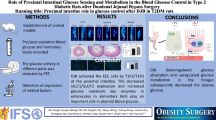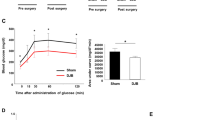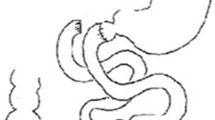Abstract
Background
Duodenal-jejunal bypass (DJB) can dramatically improve type 2 diabetes independent of weight loss and food restriction. Increasing evidence has demonstrated that brain insulin signaling plays an important role in the pathophysiology of type 2 diabetes. This study explores whether the antidiabetic effect of DJB is involved in brain insulin signaling activation and brain glucose utilization.
Methods
A diabetic rat model was established by high-fat and high-glucose diet. DJB or sham surgery was performed in diabetic rats. 18F-FDG PET scanning was used to detect glucose uptake in different organs, particularly in the brain. The levels of glucose transporters, glucose utilization-related proteins (HK1 and PFK2), insulin, and insulin signaling pathway-related proteins (InsR, IRS1/2, PI3K, and p-Akt) in the brain tissues were evaluated and analyzed.
Results
The results showed that DJB significantly improved basal glycemic parameters and reversed the decreasing glucose uptake in the brains of type 2 diabetic rats. DJB significantly increased not only the expression levels of brain insulin, IRS1/2, PI3K, and p-Akt but also the levels of the glucose utilization enzymes HK1 and PFK2 in the brain.
Conclusion
These results indicate that enhanced brain insulin signaling transduction and brain glucose utilization play important roles in the antidiabetic effect of DJB.




Similar content being viewed by others
Abbreviations
- DJB:
-
Duodenal-jejunal bypass
- T2DM:
-
Type 2 diabetes mellitus
- PI3K:
-
Phosphoinositide 3-kinase
- Akt:
-
Protein kinase B
- p-Akt:
-
Phosphorylated Akt
- GLUT1:
-
Glucose transporter type 1
- GLUT3:
-
Glucose transporter type 3
- HK1:
-
Hexokinase 1
- PFK2:
-
Phosphofructokinase 2
- InsR:
-
Insulin receptor
- IRS1:
-
Insulin receptor substrate 1
- IRS2:
-
Insulin receptor substrate 2
References
Cho NH, Shaw JE, Karuranga S, et al. IDF Diabetes Atlas: global estimates of diabetes prevalence for 2017 and projections for 2045. Diabetes Res Clin Pract. 2018;138:271–81.
Guariguata L, Whiting D, Hambleton I, et al. Global estimates of prevalence of diabetes in adults for 2013 and projections to 2035. Diabetes Res Clin Pract. 2014;103(2):137–49.
Pareek M, Schauer PR, Kaplan LM, et al. Metabolic surgery: weight loss, diabetes, and beyond. J Am Coll Cardiol. 2018;71(6):670–87.
Rubino F, Forgione A, Cummings DE, et al. The mechanism of diabetes control after gastrointestinal bypass surgery reveals a role of the proximal small intestine in the pathophysiology of type 2 diabetes. Ann Surg. 2006;244(5):741–9.
Rubino F, R’Bibo SL, del Genio F, et al. Metabolic surgery: the role of the gastrointestinal tract in diabetes mellitus. Nat Rev Endocrinol. 2010;6(2):102–9.
Cummings DE, Cohen RV. Bariatric/metabolic surgery to treat type 2 diabetes in patients with a BMI <35 kg/m2. Diabetes Care. 2016;39:924–33.
Hu C, Zhang G, Sun D, et al. Duodenal-jejunal bypass improves glucose metabolism and adipokine expression independently of weight loss in a diabetic rat model. Obes Surg. 2013;23(9):1436–44.
Cummings DE. Metabolic surgery for type 2 diabetes. Nat Med. 2012;18(5):656–8.
Cefalu WT, Rubino F, Cummings DE. Metabolic surgery for type 2 diabetes: changing the landscape of diabetes care. Diabetes Care. 2016;39(6):857–60.
Chen Z, Zhong C. Decoding Alzheimer’s disease from perturbed cerebral glucose metabolism: implications for diagnostic and therapeutic strategies. Prog Neurobiol. 2013;108:21–43.
Rubino F, Cummings DE. Surgery: the coming of age of metabolic surgery. Nat Rev Endocrinol. 2012;8(12):702–4.
Rubino F, Marescaux J. Effect of duodenal-jejunal exclusion in a non-obese animal model of type 2 diabetes: a new perspective for an old disease. Ann Surg. 2004;239(1):1–11.
Kuhre RE, Wewer Albrechtsen NJ, Larsen O, et al. Bile acids are important direct and indirect regulators of the secretion of appetite- and metabolism-regulating hormones from the gut and pancreas. Mol Metab. 2018;11:84–95.
Li M, Li H, Zhou Z, et al. Duodenal-jejunal bypass surgery ameliorates glucose homeostasis and reduces endoplasmic reticulum stress in the liver tissue in a diabetic rat model. Obes Surg. 2016;26(5):1002–9.
Li N, Huo LG, Su H, et al. Duodenum-jejunum bypass surgery (DJB) improved the glucose and lipid metabolism in Zucker diabetic rat. Diabetes. 2017;66:A681–1.
Patriti A, Facchiano E, Donini A. Effect of duodenal-jejunal exclusion in a non-obese animal model of type 2 diabetes: a new perspective for an old disease. A Ann Surg. 2004;240(2):388–9.
Hu C, Su Q, Li F, et al. Duodenal-jejunal bypass improves glucose homeostasis in association with decreased proinflammatory response and activation of JNK in the liver and adipose tissue in a T2DM rat model. Obes Surg. 2014;24(9):1453–62.
Filippi BM, Abraham MA, Yue JT, et al. Insulin and glucagon signaling in the central nervous system. Rev Endocr Metab Disord. 2013;14(4):365–75.
Molnar G, Farago N, Kocsis AK, et al. GABAergic neurogliaform cells represent local sources of insulin in the cerebral cortex. J Neurosci. 2014;34(4):1133–7.
Brüning JC, Gautam D, Burks DJ, et al. Role of brain insulin receptor in control of body weight and reproduction. Science. 2000;289(5487):2122–5.
Diggsandrews KA, Zhang X, Song Z, et al. Brain insulin action regulates hypothalamic glucose sensing and the counterregulatory response to hypoglycemia. Diabetes. 2010;59(9):2271–80.
Lam CK, Chari M, Lam TK. CNS regulation of glucose homeostasis. Physiology (Bethesda). 2009;24:159–70.
Arnold SE, Arvanitakis Z, Macauleyrambach SL, et al. Brain insulin resistance in type 2 diabetes and Alzheimer disease: concepts and conundrums. Nat Rev Neurol. 2018;14(3):168–81.
Pan RY, Li N, Zhao TK, et al. DJB surgery improved the T2DM rats glucose homeostasis, elevated the glucose utilization, and the GLUT3 expression in brain. Diabetes. 2018;67:1794–P.
Li N, Wang HJ, Su H, et al. DJB surgery improves glucose homeostasis by affecting glucose transporter expression levels in different intestinal limbs of type 2 diabetic rats and the possible underlying mechanisms. Diabetes Metab Res Rev. 2017;33
Wang H, Li N, Yan Q, et al. Tu1930 - duodenal-Jejunal bypass surgery improved glucose homeostasis through modulating the expression of SGLT1, GLUT2, T1R2 and T1R3 in different intestinal segments of type 2 diabetic rats. Gastroenterology. 2018;154(6):S1057.
Hu P, Cheng D, Huang T, et al. Evaluation of novel 64Cu-labeled theranostic gadolinium-based nanoprobes in HepG2 tumor-bearing nude mice. Nanoscale Res Lett. 2017;12(1):523.
Simpson IA, Chundu KR, Davies-Hill T, et al. Decreased concentrations of GLUT1 and GLUT3 glucose transporters in the brains of patients with Alzheimer’s disease. Ann Neurol. 1994;35(5):546–51.
Yu S, Tooyama I, Ding WG, et al. Immunohistochemical localization of glucose transporters (GLUT1 and GLUT3) in the rat hypothalamus. Obes Res. 1995;3(Suppl 5):753S–60S.
Yin X, Xu Z, Zhang Z, et al. Association of PI3K/AKT/mTOR pathway genetic variants with type 2 diabetes mellitus in Chinese. Diabetes Res Clin Pract. 2017;128:127–35.
Batterham RL, Cummings DE. Mechanisms of diabetes improvement following bariatric/metabolic surgery. Diabetes Care. 2016;39(6):893–901.
Rubino F, Schauer PR, Kaplan LM, et al. Metabolic surgery to treat type 2 diabetes: clinical outcomes and mechanisms of action. Annu Rev Med. 2010;61:393–411.
Kullmann S, Heni M, Hallschmid M, et al. Brain insulin resistance at the crossroads of metabolic and cognitive disorders in humans. Physiol Rev. 2016;96(4):1169–209.
Christian B, Swantje B, Schiöth HB, et al. Intranasal insulin enhances postprandial thermogenesis and lowers postprandial serum insulin levels in healthy men. Diabetes. 2011;60(1):114–8.
Dash S, Xiao C, Morgantini C, et al. Intranasal insulin suppresses endogenous glucose production in humans compared with placebo in the presence of similar venous insulin concentrations. Diabetes. 2015;64(3):766–74.
Heni M, Wagner R, Kullmann S, et al. Central insulin administration improves whole-body insulin sensitivity via hypothalamus and parasympathetic outputs in men. Diabetes. 2014;63(12):4083–8.
Heni M, Kullmann S, Preissl H, et al. Impaired insulin action in the human brain: causes and metabolic consequences. Nat Rev Endocrinol. 2015;11(12):701–11.
Schulingkamp RJ, Pagano TC, Hung D, et al. Insulin receptors and insulin action in the brain: review and clinical implications. Neurosci Biobehav Rev. 2000;24(8):855–72.
Kullmann S, Heni M, Veit R, et al. Selective insulin resistance in homeostatic and cognitive control brain areas in overweight and obese adults. Diabetes Care. 2015;38(6):1044–50.
Frank S, Wilms B, Veit R, et al. Altered brain activity in severely obese women may recover after Roux-en Y gastric bypass surgery. Int J Obes. 2014;38(3):341–8.
Scholtz S, Miras AD, Chhina N, et al. Obese patients after gastric bypass surgery have lower brain-hedonic responses to food than after gastric banding. Gut. 2014;63(6):891–902.
Hunt KF, Dunn JT, Le RC, et al. Differences in regional brain responses to food ingestion after Roux-en-Y gastric bypass and the role of gut peptides: a neuroimaging study. Diabetes Care. 2016;39(10):1787–95.
Tuulari JJ, Karlsson HK, Hirvonen J, et al. Weight loss after bariatric surgery reverses insulin-induced increases in brain glucose metabolism of the morbidly obese. Diabetes. 2013;62(8):2747–51.
Lam TK, Gutierrezjuarez R, Pocai A, et al. Regulation of blood glucose by hypothalamic pyruvate metabolism. Science. 2005;309(5736):943–7.
Lópezgambero AJ, Martínez F, Salazar K, et al. Brain glucose-sensing mechanism and energy homeostasis. Mol Neurobiol. 2019;56(2):769–96.
Hwang JJJL, Rangel ES, Fan X, et al. Glycemic variability and brain glucose 1 levels in T1DM. Diabetes. 2019;68(1):163–71.
Hirvonen J, Virtanen KA, Nummenmaa L, et al. Effects of insulin on brain glucose metabolism in impaired glucose tolerance. Diabetes. 2011;60(2):443–7.
Minchenko DO, Kharkova AP, Hubenia OV, et al. Insulin receptor, IRS1, IRS2, INSIG1, INSIG2, RRAD, and BAIAP2 gene expressions in glioma U87 cells with ERN1 loss of function: effect of hypoxia and glutamine or glucose deprivation. Endocr Regul. 2013;47(1):15–26.
Bathina S, Das UN. Dysregulation of PI3K-Akt-mTOR pathway in brain of streptozotocin-induced type 2 diabetes mellitus in Wistar rats. Lipids Health Dis. 2018;17(1):168.
Acknowledgments
Authors would like to thank Jing-Yue Yan, PhD, candidate in the College of Pharmacy, Ohio State University, OH, 43210, USA, for editing and revising the manuscript.
Funding
MQ is funded by the National Natural Science Foundation of China (81871892), Natural Science Foundation of Shandong Province (ZR2015HL128), and Technology Development Plan of Weifang (2018YX027). ZG and MQ are funded by the National Natural Science Foundation of China (31671208). JD and MQ are funded by the Natural Science Foundation of China (81500798). ZL is funded by the Natural Science Foundation of China (81471048). XW is funded by the Natural Science Foundation of China (81503108).
Author information
Authors and Affiliations
Contributions
Designed and led the study and wrote the manuscript: MQ, ZG. Performed the experiments and statistical analysis data: NL, QY, QJ, RP, HW, BJ, XL, JD, YW, XW, MZ, QM, XL, ZL. All co-authors commented on the manuscript and agreed with the manuscript results and conclusions.
Corresponding authors
Ethics declarations
Conflict of Interest
The authors declare that they have no conflicts of interest.
A Statement of Animal Rights
This study was carried out in accordance with the recommendations of Weifang Medical University, China. The experimental protocol was approved by the Research Ethics Committee of Weifang Medical University, China.
Additional information
Publisher’s Note
Springer Nature remains neutral with regard to jurisdictional claims in published maps and institutional affiliations.
Electronic Supplementary Material
Supplemental Figure
A schematic model showing that DJB improves type 2 diabetes by increasing brain insulin and activating brain insulin signaling and glucose metabolism. DJB increases brain insulin levels and activates insulin signaling by increasing the expression levels of IRS1/IRS2, PI3K-Akt, HK1 and PFK2. DJB also increases the expression of GLUT3 and glucose uptake in the brain. These changes improve glucose aerobic oxidation and provide ATP for brain activities. (PNG 574 kb)
ESM 2
(DOCX 17 kb)
ESM 3
(DOCX 16 kb)
ESM 4
(DOCX 16 kb)
Rights and permissions
About this article
Cite this article
Li, N., Yan, QT., Jing, Q. et al. Duodenal-Jejunal Bypass Ameliorates Type 2 Diabetes Mellitus by Activating Insulin Signaling and Improving Glucose Utilization in the Brain. OBES SURG 30, 279–289 (2020). https://doi.org/10.1007/s11695-019-04153-3
Published:
Issue Date:
DOI: https://doi.org/10.1007/s11695-019-04153-3




